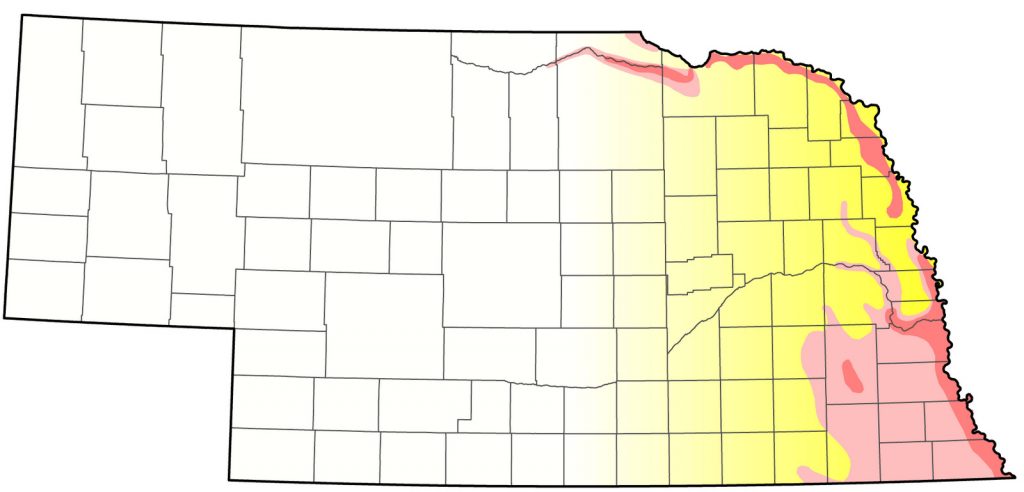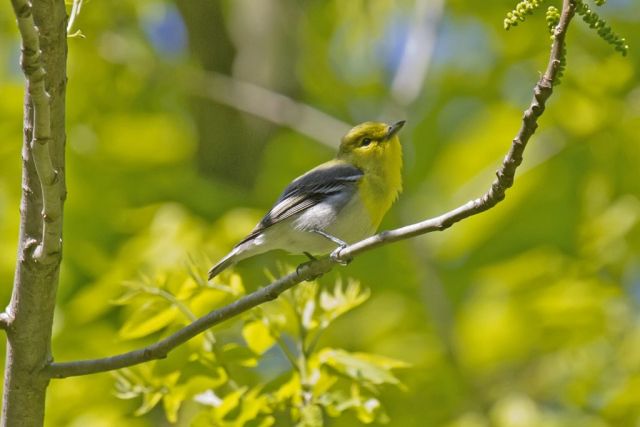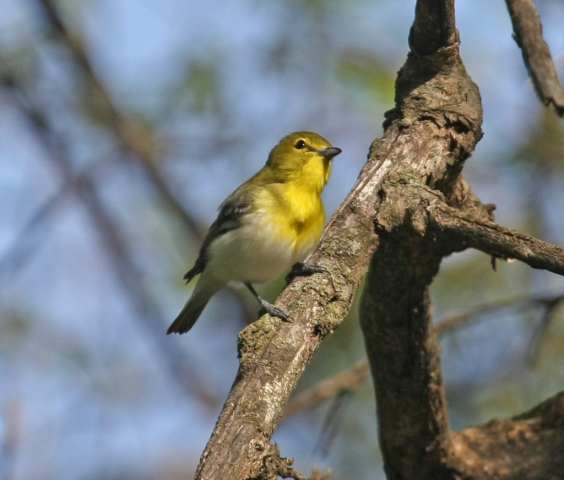Vireo flavifrons
Status: Increasing. Fairly common regular spring migrant east, rare east-central, rare casual west-central and west. Fairly common regular breeder east. Fairly common regular fall migrant east, rare casual elsewhere.

Documentation: Specimen: UNSM ZM10537, 28 Apr 1888 (two birds) Peru, Nemaha Co.
Taxonomy: No subspecies are recognized (AviList 2025).
Spring: Apr 23, 23, 24 <<<>>> summer
Arrival is in mid-late Apr.
Most of the few reports away from the breeding range, other than breeding season reports discussed under Summer, are of spring migrants, including these from the Panhandle: 18 May 2018 Oshkosh, Garden Co, 19 May 2023 Kimball Co, 21 May 2022 Kimball Co, 25 May 1980 Dawes Co (Rosche 1982), 29 May 1949 Dawes Co, and 6 Jun 2017 Smith Lake WMA, Sheridan Co. Two reports from Crescent Lake NWR, Garden Co, probably of the same bird, were 18 May and 12 Jun 2010. Close to the Panhandle was one at Lake McConaughy, Keith Co 5 May 2002.
- High counts: 17 in Sarpy Co 13 May 1995, 14 at Wilderness Park, Lancaster Co 11 May 2019, and 11 at Ponca SP, Dixon Co 15 May 2021.
Summer: BBS Trend Analysis shows an average annual increase 1966-2019 (Sauer et al 2020) of 1.7% (95% C.I.; -0.65, 5.11) in Nebraska; increases may be contributing to gradual range expansion westward.
Yellow-throated Vireo is most numerous in the southeast and in the Missouri River Valley. It summers regularly north in the Missouri River Valley to the Gavin’s Point Dam area in Cedar Co. There are about 14 records Jun-Jul in Knox Co, most in the Verdigre Creek drainage, but few farther west. In Holt and Boyd Cos there are five records: three for Holt Co 3-8 Jun and one for Boyd Co 4 Jun, all possibly spring migrants, and one along 470 Ave, Boyd Co 12 Jul 2022. Brogie and Mossman (1983) found no Yellow-throated Vireos west of Holt and Boyd Cos in 1982 and suggested that “breeding populations are unstable this far west.” There are older records for Brown Co, where Short (1965) found three scattered singing males and a female during late May and Jun 1964 along Plum Creek northwest of Ainsworth and collected a male with enlarged testes 17 Jun in open second growth woods. Since then there are sporadic records for Brown Co, with increasing records since 2016: 30 Jun-1 Jul 1969, 30 Jun 1972, 30 Jun 1973, in 2016 three reports of probable migrants 1-6 Jun and another 10 Jun, 17 Jun 2014, 15 Jun 2020, 23 Jun 2022, and 17 Aug 2023. In Keya Paha Co 17 Jun 2020 on Niobrara Valley Preserve property and 16 Jun 2023 at Springbrook Campground, the latter carrying nest material; and in Cherry Co there are reports 4-5 Jun, likely migrants: 4 Jun 2018 on Nature Conservancy Property, 5 Jun 2017 Sharp’s Campground, and a later report 13 Jul 2001 at Valentine.
There are a few reports in the Elkhorn River Valley, where it summers occasionally north to Cuming Co, with only these reports further west: 9 Jun 2021 Stanton Co, 18 Jul 2017 (2) Madison Co, and at Grove Lake, Antelope Co 11 Jun and 6 Jul 2008, 12 Jun 2011, and 23 Jun-12 Jul 2022.
In the Loup River drainage, most of the few reports are of spring strays, although it was reported in Custer Co 1 Jul 1972, and at NNF Bessey, Thomas Co 22-24 May 1990, when two birds thought to be a territorial pair foraged for three days in a cottonwood along the Middle Loup River; no evidence of nesting was noted (Cortelyou 1990) and the report was listed as “hypothetical” by Bray (1994). It was reported there, however, 15 May 2015, and there are three additional Loup River drainage reports from Custer Co, all likely migrants: 11 May 2010, 28 May 1968, and 3 Jun 1978. One was at Calamus Reservoir, Loup Co 25 Jun 2012.
The only record for Crescent Lake NWR, Garden Co is for 12 Jun 2010.
Breeding in the Platte River Valley extends regularly west only to Dodge and Saunders Cos, although there are breeding season reports in Platte Co 14 Jul 2011 and Colfax Co 14 Jun 2020, 24 Jun 2011, and 27 Jun 2021.
There are numerous and increasing reports in and near the Salt Creek drainage in Lancaster Co, where the species has recently become established in low numbers in the Wilderness Park area. Mollhoff (2016) shows confirmed breeding in Lancaster Co. Singles near Denton 8 Jun 2018 and at Spring Creek Prairie 5-6 Jun 2019 were likely migrants.
Although the Big and Little Blue River drainages host low numbers, the species appears to be establishing there. On the Big Blue there are reports north to Seward Co 18 Jun 2013 and 13 Jul 2013, possibly the same bird, and in Saline and Gage Cos there are six reports 2-5 Jun, likely migrants, but reports 20 Jun 2021, 11-12 Jul 2016, and 3 Aug 2015 at Homestead NM, Gage Co may have been breeders. On the Little Blue, there are two mid-Jun through Jul reports for Thayer Co, including one carrying food at Little Blue WMA 19 Jun 2023, the only documented breeding record for the Little Blue area, and one at the Highway 5 Little Blue River crossing 25 Jun 2017. In Jefferson Co, there are at least nine late Jun-Jul reports from about eight locations, suggesting an establishing population in the area. A very early nesting record at Fairbury was for 9 May 1939 (Mollhoff 2022).
- Breeding Phenology:
Nest building: 8 May-16 Jun
Eggs: 24 May-11 Jun (Mollhoff 2022) - Nestlings: 9 May (very early; Callaway and Callaway 1939, Mollhoff 2022)
Fledglings: 16 Jun-3 Jul
Fall: summer <<<>>> Sep 28, 29, 29
Departure is completed by late Sep.
Fall reports away from the eastern breeding and expected migration corridor range are few; apart from the Dundy Co late date above, the only other such reports are 18 Jul 2016 Sioux Co, 17 Aug 2023 Brown Co, 4 Sep 2021 Kimball Co, 15 Sep 1982 Boone Co, 18 Sep 2024 Lake McConaughy, Keith Co, 26 Sep 2023 Adams Co.
An extraordinary record was 26 Oct 2004 Dundy Co.
- High counts: 6 at Fontenelle Forest 10 Aug 2011, 6 at Wilderness Park, Lancaster Co 1 Sep 2019, and 6 there 12 Sep 2020.
Images
Abbreviations
BBS: Breeding Bird Survey
NNF: Nebraska National Forest
NM: National Monument
NWR: National Wildlife Refuge
SP: State Park
UNSM: University of Nebraska State Museum
WMA: Wildlife Management Area (State)
Literature Cited
AviList Core Team, 2025. AviList: The Global Avian Checklist, v2025. https://doi.org/10.2173/avilist.v2025.
Bray, T.E. 1994. Habitat utilization by birds in a man-made forest in the Nebraska Sandhills. Master’s thesis, University of Nebraska-Omaha, Omaha, Nebraska, USA.
Brogie, M.A., and M.J. Mossman. 1983. Spring and summer birds of the Niobrara Valley Preserve, Nebraska: An annotated checklist. NBR 51: 44-51.
Callaway, S., and A. Callaway. 1939. The Yellow-throated Vireo nesting at Fairbury, Jefferson County. NBR 7: 29.
Cortelyou, R.G. 1990. 1990 (Sixty-fifth) Spring Occurrence Report. NBR 58: 58-83.
Mollhoff, W.J. 2016. The Second Nebraska Breeding Bird Atlas. Bull. Univ. Nebraska State Museum Vol 29. University of Nebraska State Museum, Lincoln, Nebraska, USA.
Mollhoff, W.J. 2022. Nest records of Nebraska birds. Nebraska Ornithologists’ Union Occasional Paper Number 9.
Rosche, R.C. 1982. Birds of northwestern Nebraska and southwestern South Dakota, an annotated checklist. Cottonwood Press, Crawford, Nebraska, USA.
Sauer, J.R., W.A. Link, and J.E. Hines. 2020.The North American Breeding Bird Survey, Analysis Results 1966 – 2019: U.S. Geological Survey data release.
Short, L.L., Jr. 1965. Bird records from northern Nebraska during the breeding season. NBR 33: 2-5.
Recommended Citation
Silcock, W.R., and J.G. Jorgensen. 2025. Yellow-throated Vireo (Vireo flavifrons). In Birds of Nebraska — Online. www.BirdsofNebraska.org
Birds of Nebraska – Online
Updated 26 Aug 2025


